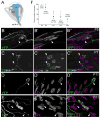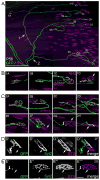Delayed synapse elimination in mouse levator palpebrae superioris muscle
- PMID: 21681746
- PMCID: PMC3268260
- DOI: 10.1002/cne.22700
Delayed synapse elimination in mouse levator palpebrae superioris muscle
Abstract
At birth, synaptic sites in developing rodent muscles are innervated by numerous motor axons. During subsequent weeks, this multiple innervation disappears as one terminal strengthens, and all the others are eliminated. Experimental perturbations that alter neuromuscular activity affect the rate of synaptic refinement, with more activity accelerating the time to single innervation and neuromuscular blockade retarding it. However, it remains unclear whether patterns of muscle use (driven by endogenous neuronal activity) contribute to the rate of synapse elimination. For this reason we examined the timing of supernumerary nerve terminal elimination at synapses in extraocular muscles (EOMs), a specialized set of muscles controlling eye movements. On the basis of their exceptionally high patterns of activity, we hypothesized that synaptic refinement would be greatly accelerated at these synapses. We found, however, that rates of synaptic refinement were only modestly accelerated in rectus and oblique EOMs compared with synapses in somite-derived skeletal muscle. In contrast to these results, we observed a dramatic delay in the elimination of supernumerary nerve terminals from synapses in the levator palpebrae superioris (LPS) muscle, a specialized EOM that initiates and maintains eyelid elevation. In mice, natural eye opening occurs at the end of the second postnatal week of development. Thus, although synapse elimination is occurring in most EOMs and somite-derived skeletal muscles, it appears to be dramatically delayed in a set of specialized eyelid muscles that remain immobile during early postnatal development.
Copyright © 2011 Wiley-Liss, Inc.
Figures








Similar articles
-
Neuromuscular Junction Development Differs Between Extraocular and Skeletal Muscles and Between Different Extraocular Muscles.Invest Ophthalmol Vis Sci. 2024 May 1;65(5):28. doi: 10.1167/iovs.65.5.28. Invest Ophthalmol Vis Sci. 2024. PMID: 38767908 Free PMC article.
-
Anatomical variations of the levator palpebrae superioris, including observations on its innervation and intramuscular nerves' distribution pattern.Ann Anat. 2020 Mar;228:151439. doi: 10.1016/j.aanat.2019.151439. Epub 2019 Nov 11. Ann Anat. 2020. PMID: 31726207
-
Prevalence and elimination of sibling neurite convergence in motor units supplying neonatal and adult mouse skeletal muscle.J Comp Neurol. 2012 Oct 1;520(14):3203-16. doi: 10.1002/cne.23091. J Comp Neurol. 2012. PMID: 22430826
-
Extreme Tolerance of Extraocular Muscles to Diseases and Aging: Why and How?Int J Mol Sci. 2024 May 3;25(9):4985. doi: 10.3390/ijms25094985. Int J Mol Sci. 2024. PMID: 38732204 Free PMC article. Review.
-
Interactions between nerve and muscle: synapse elimination at the developing neuromuscular junction.Dev Biol. 1993 Mar;156(1):1-10. doi: 10.1006/dbio.1993.1054. Dev Biol. 1993. PMID: 8449362 Review.
Cited by
-
Mechanisms controlling neuromuscular junction stability.Cell Mol Life Sci. 2015 Mar;72(6):1029-43. doi: 10.1007/s00018-014-1768-z. Epub 2014 Oct 31. Cell Mol Life Sci. 2015. PMID: 25359233 Free PMC article. Review.
-
Spike timing plays a key role in synapse elimination at the neuromuscular junction.Proc Natl Acad Sci U S A. 2012 Jun 19;109(25):E1667-75. doi: 10.1073/pnas.1201147109. Epub 2012 May 22. Proc Natl Acad Sci U S A. 2012. PMID: 22619332 Free PMC article.
-
Neuromuscular Junction Development Differs Between Extraocular and Skeletal Muscles and Between Different Extraocular Muscles.Invest Ophthalmol Vis Sci. 2024 May 1;65(5):28. doi: 10.1167/iovs.65.5.28. Invest Ophthalmol Vis Sci. 2024. PMID: 38767908 Free PMC article.
-
Losing the battle but winning the war: game theoretic analysis of the competition between motoneurons innervating a skeletal muscle.Front Comput Neurosci. 2012 Mar 30;6:16. doi: 10.3389/fncom.2012.00016. eCollection 2012. Front Comput Neurosci. 2012. PMID: 22479244 Free PMC article.
-
Diminution of voltage threshold plays a key role in determining recruitment of oculomotor nucleus motoneurons during postnatal development.PLoS One. 2011;6(12):e28748. doi: 10.1371/journal.pone.0028748. Epub 2011 Dec 9. PLoS One. 2011. PMID: 22174887 Free PMC article.
References
-
- Balice-Gordon RJ, Chua CK, Nelson CC, Lichtman JW. Gradual loss of synaptic cartels precedes axon withdrawal at developing neuromuscular junctions. Neuron. 1993;11(5):801–815. - PubMed
-
- Balice-Gordon RJ, Lichtman JW. Long-term synapse loss induced by focal blockade of postsynaptic receptors. Nature. 1994;372(6506):519–524. - PubMed
-
- Benoit P, Changeux JP. Consequences of tenotomy on the evolution of multiinnervation in developing rat soleus muscle. Brain Res. 1975;99(2):354–358. - PubMed
Publication types
MeSH terms
Substances
Grants and funding
LinkOut - more resources
Full Text Sources

